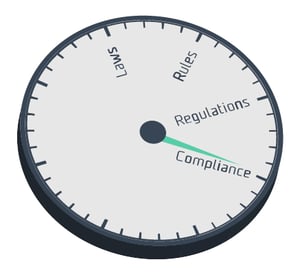Trucking Capacity Shortage - The State of Affairs

The Perfect Storm
'Perfect storm' has been used to describe the trucking capacity shortage before. Most who work in supply chain operations have seen the cycles of capacity constraints come and go.
But this time it's different. The trucking market in the US is at 100% percent capacity, as tight as it has been since 2004.[1] And rates are climbing as a result. According to data from load-board operator DAT, rates in January 2018 were up between 25 and 36 percent year over year, while the ratio of loads to capacity was 185 percent higher than it was in January 2017. [2]
By the end of February DAT reported there were almost 10 loads available per truck.[3] As a result truckers are turning down loads at an alarming rate. One major trucking company that regularly hauls over 6,000 loads a week has been turning down 800 to 1,200 loads each day.[4] Another reported rejecting loads from major retailers like Walmart and Lowe's at a rate of 10,000 a week[5]. If giants like these can't get loads picked up, what chance do smaller shippers have?
The factors contributing to this capacity crisis include the new electronic logging devices (ELD) mandate in the U.S. and Canada, the shortage of drivers, a booming economy – including e-commerce and (temporarily, at least) bad weather. Let's take a look at how these affect the industry.
Regulatory woes
 Implemented in December 2017, with full enforcement to take effect in the U.S. in April 2018, the ELD mandate has instantly taken capacity off the road. With the electronic logging devices required in every truck, drivers now face severe penalties if they do not comply with the Hours of Service (HoS) rules, which mandate, among other things, a 14-hour day, of which only 660 minutes can be behind the wheel.
Implemented in December 2017, with full enforcement to take effect in the U.S. in April 2018, the ELD mandate has instantly taken capacity off the road. With the electronic logging devices required in every truck, drivers now face severe penalties if they do not comply with the Hours of Service (HoS) rules, which mandate, among other things, a 14-hour day, of which only 660 minutes can be behind the wheel.
Estimates run from a 15 to 20 percent capacity loss for some trucking companies. Routes that previously required one day of transit time now may require twice that long to accommodate the drivers' hours.[6] For a graphic demonstration of the effects, just take a look at the massive numbers of transports parked in truck stops, and along exit ramps on any freeway at any hour of the day. Every minute they're not driving is capacity lost.
Additional capacity has been sidelined through the introduction period, as companies and small operators who left it to the last minute are having trouble finding ELD system vendors who have the time and capacity themselves to do the installations. [7] This may worsen after April 1st, when full enforcement comes into effect, and non-compliant trucks may be forced to park instead of just paying a fine.
Adding to the regulatory headache, food manufacturers must now comply with new food safety rules that make transportation needs more specific and hard to meet. [8] Effectively this reduces the available pool of trucks that can carry their loads.
Drivers needed
Exacerbating the HoS issue is the well-known driver shortage. First documented about 2005, with a shortfall in the U.S. of 20,000, the problem intensified to an estimated 50,000 drivers needed at the end of 2017. That will balloon to 174,000 in 2026, says the American Trucking Association.[9] That's bad enough, and other estimates say the ELD rules could bump that number as high as 400,000.[10]
The situation is only getting worse thanks to the advancing age of drivers – at the moment it's 55 – along with competition from other occupations that don't have trucking's drawbacks of being solitary and away from home. The ELD mandate is also reportedly accelerating retirements among older drivers who don't care to learn the new systems.
The industry has also done a poor job of attracting different demographics. The driver population is disproportionately male at 94%. And efforts to attract ethnic minorities into the driver pool has not boosted the supply of drivers sufficiently.
Boom times
Economic growth is making the problem worse. The boom of e-commerce and omni-channel retail is gobbling up capacity as shoppers buy more product that has to be moved multiple times, including unprecedented levels of returns. Late in 2017 U.S. industrial production reached its highest level since 2010[11], and the 2017 holiday shopping season was one for the record books.
Economic indicators in the United States point to further growth, reflecting strong manufacturing numbers, a surge in home building, record low unemployment and positive financial conditions.[12] All these net out to more economic activity, meaning continuing increased demand for freight transportation. Shipments have increased by 12.5 percent year over year and expenditures on freight have climbed by 14.5 percent.[13]
[1] https://www.thestreet.com/story/14504072/1/consumer-brands-to-face-increased-costs-as-pressure-builds-on-trucking-industry.html
[2] https://www.dat.com/industry-trends/trendlines
[3] https://www.trucks.com/2018/01/29/freight-rates-truckers-soar/
[4] http://www.logisticsmgmt.com/article/forget_the_perfect_stormthis_is_looking_like_a_full_fledged_frankenstorm
[5] https://www.wsj.com/articles/trucking-rates-come-down-a-bit-but-problems-persist-for-shippers-1518729334?shareToken=stfef90f2b9e8b4f1fbd110edf1e526549&reflink=article_email_share
[6] https://www.wsj.com/articles/tight-trucking-market-has-retailers-manufacturers-paying-steep-prices-1515150000
[7] https://www.wsj.com/articles/trucking-industry-worries-new-rule-could-raise-costs-1513359508
[8] https://www.wsj.com/articles/trucking-industry-worries-new-rule-could-raise-costs-1513359508
[9] http://progressive1.acs.playstream.com/truckline/progressive/ATAs%20Driver%20Shortage%20Report%202017.pdf
[10] http://www.drivershortage.ca/?p=958#.WprMEYJG1hF
[11] https://www.wsj.com/articles/a-shortage-of-trucks-is-forcing-companies-to-cut-shipments-or-pay-up-1516789800?mod=djemlogistics
[12] https://www.reuters.com/article/us-usa-economy/u-s-jobless-claims-near-45-year-low-as-economic-outlook-brightens-idUSKCN1G61OX
[13] http://www.thetrucker.com/News/Story/Tightcapacitycausingpricingpowerinflationconcernsraised

